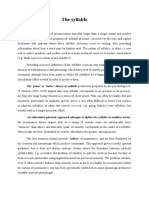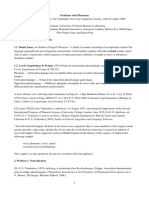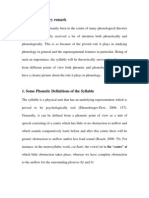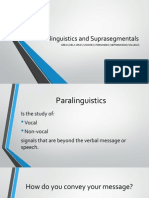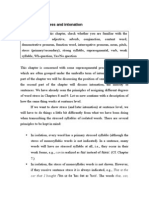Pike - Tonemic/intonemic Correlation in Mazahua
Pike - Tonemic/intonemic Correlation in Mazahua
Uploaded by
anarchdeckardCopyright:
Available Formats
Pike - Tonemic/intonemic Correlation in Mazahua
Pike - Tonemic/intonemic Correlation in Mazahua
Uploaded by
anarchdeckardOriginal Title
Copyright
Available Formats
Share this document
Did you find this document useful?
Is this content inappropriate?
Copyright:
Available Formats
Pike - Tonemic/intonemic Correlation in Mazahua
Pike - Tonemic/intonemic Correlation in Mazahua
Uploaded by
anarchdeckardCopyright:
Available Formats
Tonemic-Intonemic Correlation in Mazahua (Otomi) Author(s): Eunice V. Pike Source: International Journal of American Linguistics, Vol. 17, No.
1 (Jan., 1951), pp. 37-41 Published by: The University of Chicago Press Stable URL: http://www.jstor.org/stable/1262865 Accessed: 06/12/2009 00:48
Your use of the JSTOR archive indicates your acceptance of JSTOR's Terms and Conditions of Use, available at http://www.jstor.org/page/info/about/policies/terms.jsp. JSTOR's Terms and Conditions of Use provides, in part, that unless you have obtained prior permission, you may not download an entire issue of a journal or multiple copies of articles, and you may use content in the JSTOR archive only for your personal, non-commercial use. Please contact the publisher regarding any further use of this work. Publisher contact information may be obtained at http://www.jstor.org/action/showPublisher?publisherCode=ucpress. Each copy of any part of a JSTOR transmission must contain the same copyright notice that appears on the screen or printed page of such transmission. JSTOR is a not-for-profit service that helps scholars, researchers, and students discover, use, and build upon a wide range of content in a trusted digital archive. We use information technology and tools to increase productivity and facilitate new forms of scholarship. For more information about JSTOR, please contact support@jstor.org.
The University of Chicago Press is collaborating with JSTOR to digitize, preserve and extend access to International Journal of American Linguistics.
http://www.jstor.org
TONEMIC-INTONEMIC
CORRELATION IN MAZAHUA (OTOMI) EUNICEV. PIKE
SUMMERINSTITUTE OF LINGUISTICS
0. 1. 2. 3. 4. 5. 6. 7.
Tonemes and intonemes Tonemes Stress Intonemes and intonation morphemes Pitch vacuums and acquired tonemes Lost tonemes and intonemic strength Adjacent toneme and intoneme Implications
0. Tonemes and intonemes.l Mazahua has a phonemic tone system, but it has a THE PITCHES OF ALL SYLLABLES WHICH phonemic intonation2 system as well. PhoSYS- DO NOT IMMEDIATELY PRECEDE WORD SPACE nemic tone, constituting the TONEMIC TEM,is used in connection with the lexical ARE THOSE OF THE TONEMIC SYSTEM. THE meaning of words; phonemic intonation, PITCH OF ANY SYLLABLE IMMEDIATELY PREconstituting the INTONEMIC SYSTEM, adds CEDING WORD3 SPACE IS PART OF THE INSYSTEM. When a word is shortened emotional meaning to words and phrases or TONEMIC indicates the attitude of the speaker. Given in length, overlap might be expected to the segmental phonemes /zapha/ the inde- occur, but instead of this, any toneme which pendent operation of these two systems can would conflict with an intoneme is dropped. be illustrated. If the first syllable contains a When a word is lengthened, the intoneme high toneme, the meaning of the word is is moved from its accustomed syllable to a
1 This paper was written at the University of Oklahoma, as a member of the staff of the Summer Institute of Linguistics. The data were gathered under the auspices of the Summer Institute of Linguistics in a field trip in the fall of 1948 in collaboration with Hazel Spotts and Mildred Kiemele Muro. Some further data were added in a second trip in January 1950 and this material was presented, under a slightly different title, to the summer meeting of the Linguistic Society of America, 29 July 1950. 2 Y. R. Chao in Tone and Intonation in Chinese, Bulletin of the National Research Institute of History and Philology of the Academia Sinica, 4, Pt. 2 (1933), reports both tone and intonation in Chinese, but in that case the intonation is fused to the tonal element. Einar Haugen, at the Ann Arbor meeting of the Linguistic Society of America, July 1949, presented a paper entitled, The Stress Tones of Modern Norwegian. Perhaps lexical and intonational pitch in Norwegian has a relationship closer to that described for Mazahua than does Chao's Mandarin. 37
GUN.If that high toneme is replaced by low, the word is no longer one meaning GUN, but has become the word LAKE. These words remain GUN and LAKE respectively even when the high intoneme of the second syllable is replaced by a low intoneme, or a mid intoneme, or a sequence of intonemes; pitch variations on the second syllable change only the emotional coloring with which the word is said. Thus, the two systems operate on different syllables without overlap.
later one, and the PITCHVACUUM created by
such a move is filled by an inserted predictable toneme. 1. Tonemes. Three tonemes, high, low, and falling, none of which are perceptibly modified by the segmental4 phonemes,
occur in Mazahua. The low toneme contains two ALLOTONES: the allotone of most frequent occurrence is a nonglided low, the other occurs occasionally and noncontras3
4 For the analysis of the segmental phonemes and for the grammatical material used throughout this paper, I am indebted to Miss Hazel Spotts. The consonants as listed by Miss Spotts are:
p, t, c, c, k, kw, ?; b, d, g, gw; s, s, z, , h; m, n,
For a definition of 'word' see Section 2.
f; w, y; r, 1. The vowels as listed by her are: i,
e, e,e,a, , 0o, , U,q, o,,, A. For the description of the allophones see her article, Mazahua Vowel Harmony, Consonant Sequences, and Intonation Placement, as yet unpublished.
38
INTERNATIONAL
JOURNAL
OF AMERICAN
LINGUISTICS
VOL. XVII
tively in slow speech as a quick glide starting at low and going in the direction of high. The high toneme has only one allotone, a nonglided high. The falling toneme is always glided, starting at high and ending on low. The tonemes may be illustrated on words in isolation as follows: zapho gun, zapho lake; hyara ashes, hyara sun; ngShno a professional corn cake maker, ngahna bee. Contrasting after a low toneme: in-zapho your gun, in-zApho your lake; in-hyara your ashes, in-hyAra your sun; i-ng6hn9 your professional corn cake maker, i-ngohno your bee. Contrasting after a high toneme: in-zapho my gun, in-zapha my lake; in-hyara my ashes, in-hyara my sun; in-s6ge you leave, in-s6ge you left, in-sbge you spit (present tense). The tonemes may be illustrated on three syllable stems: zahkihfii cactus, mbat?6apha pineapple drink, ndenchora sheep; nd6hpara buzzard, thasiwi fan, besoma very dark; kanfiba rubbish, t?bichi volcano, ?nichihmi church; c?ingbro calf, ndez4ini half moon, hanzitho a few. Because the falling toneme has a restricted distribution, the greatest differentiation of tonemic pitch occurs only on stressed syllables. The falling toneme occurs only on a stressed syllable, that is, on the first syllable of the stem. Thus far a falling toneme has not been observed on a proclitic, nor on any syllable of the stem other than the first. If a word with a falling toneme on the first syllable of the stem is compounded in such a way that that syllable is no longer the first, then the falling toneme is replaced by a high toneme. For this reason the falling toneme of ngnfii hen is replaced by a high toneme when compounded with c?ihke little to form the compound c?inganiichicken. 2. Stress. A word, which may include one or more proclitics, is phonologically determined; it carries only one high stress and is constituted phonetically of a stress group
(possibly a rhythm unit or ABDOMINAL
PULSE);5 it is the minimal unit which may
occur in isolation; following any word, given proper context, there is potentiality for pause. The word begins on any syllable which immediately follows an intoneme-carrying syllable. Between words a space is written to symbolize their borders. Stress, accompanied by a nonphonemic lengthening of the vowel, occurs on the first syllable of the stem. The stem begins on the first syllable of a nonprocliticized word. Two classes of proclitics, both of which are monosyllabic but one of which is more closely bound than the other, may precede the stem, and are symbolized by hyphen following the last of them. The stress, therefore, falls on the first syllable following hyphen, or if no hyphen occurs, then following space.6 For example, th's?~ hat, in-this?g my hat, khan6-za?a at the tree. 3. Intonemes and intonation morphemes. The pitch of word-final syllables pertains to intonation. Three phonemic registers can be demonstrated for the intonation system. High is symbolized by the number 1, low by 3, mid by 2. For example: th4s?9' a cigar, you say?, ths?;2. ... and a cigar ..., th's?, 3 a cigar; this?;1 a hat, you say?, this?Q2... and a hat.. ., this?g3 a hat. Phonetically the low intoneme of the intonation system appears to be the same
6 The term ABDOMINAL PULSE was suggested to me by Kenneth L. Pike. 6 An alternate description, granting word borders on the phonological evidence already given, could present stress as phonemic since the proclitic nature is nondeterminable on the phonological level. Within such an analysis the examples would be written 'this?a hat, in'this?q my hat,
khAne'zs3a at the tree; it seems preferable to assume the overlapping of phonological and grammatical layers at this point and to indicate certain (here undefined) pre-stem grammatical boundaries by a hyphen. By implication this allows for prediction of stress within the phonologically defined word. Any reader who prefers the second however, should merely re-define hypothesis, hyphen for himself to mean 'symbol of stress, placed before the stressed syllable'.
NO. 1
TONEMIC-INTONEMIC CORRELATION IN MAZAHUA (OTOMI)
39
pitch as that of the nonglided allotone of the low toneme. The high intoneme, however, is considerably higher in pitch than the high toneme of the tonemic system. For example, in the word this?23 a hat, the phonetic pitch of the two syllables seems to be the same. In the word this?~' a cigar, you say? the second syllable is considerably higher in pitch than the first, even though the first is a high toneme and the second is a high intoneme. The mid intoneme has two allotones differing slightly in relative height. The allotone lower in pitch appears to be the same height as the high toneme of the tonemic system;7 the other allotone of the mid intoneme is slightly higher in pitch than that same high toneme. Phrase medially the lower allotone occurs, but in phrase-final position these allotones of the mid intoneme seem to be in free nonphonemic variation with each other.8 Intonation morphemes may be comprised either of a single intonemic pitch on a wordfinal syllable, or of a sequence of two such pitches on a word-final syllable: the sequence is never distributed over more than one syllable. The following intonation morphemes are among the more common used in Mazahua speech. The morpheme consisting of a single low
7 This homonymity between some of the allotones of the tonemic system and some of the allotones of the intonemic system, might suggest the possibility of combining the two into a single phoneme. To us, however, it seems that the tonemic material and the intonemic material constitute two separate systems. The presence of these two systems is indicated by their different distribution, by their different types of allotones, and by the different grammatical-semantic characteristics of the morphemes into which they enter, or which they constitute. We do not wish to combine into a single phoneme allophones-even homophonous ones-taken from two different systems. 8 The possibility that we may yet find them in contrast one with the other, however, has not been completely eliminated. If such a contrast does later appear, four phonemic registers will have to be postulated.
intoneme on the phrase-final syllable is the one most frequently used to signal normal colorless finality, and hence to terminate a statement: dA-bezo2 k?mi-menzume2 ambAro3There was a man from Atlacomulco. It is used in response to a question: tVophal Written, you say?; t?Spha3 (no, I said,) plow. The morpheme consisting of a single high intoneme on the phrase-final syllable is most commonly used when the speaker's attitude reflects the query, Is that what you said? or Is that what you mean?: nd6sahnal A hawk, you say?; ndanh6aral A sheep, you say?; khaha1 The owner, you say?. The morpheme indicating that something is expected to follow consists of a single mid intoneme and frequently occurs before a hna2 calves, pause: c?ingero2, c?infoi2, ... This same morpheme, chickens, turkeys phrase medially without pause, signals sequence, or continuity, and is the normal intonemic ending for phrase-medial words: dh-ndisq2 ma-Ai?bi2 6-bara3 A woman is washing her jar; mi-h ?2 da-zapha2 ming6he2 mbahtizi3 He had a gun, he was a hunter of ducks. An intonation morpheme frequently used to show surprise and actualizing as a glide from mid to high, consists of a sequence of a mid intoneme followed by a high intoneme on the phrase-final syllable. r,-sqr 2-L Tomorrow?! An intonation morpheme frequently used to show anger or disgust and actualizing as a glide from mid to low consists of a sequence of a mid intoneme followed by a low intoneme. ?yahka2-3Hey, you, give it to me! An intonation morpheme used in calling to someone or in shouting a message consists of a glided sequence of a high intoneme followed by a low intoneme on the phrasefinal syllable. This morpheme also carries Come! emphatic stress and length: chAM?dA"3 hani-ma?al-3 Where are you going? 4. Acquired tonemes. We have seen that certain syllables carry tonemes and that
40
INTERNATIONAL JOURNAL OF AMERICAN LINGUISTICS
VOL. XVII
others carry intonemes. Now words, phonologically defined, may be lengthened by the addition of an enclitic syllable. These enclitics become part of the word to which they are phonologically bound and carry the intonation for that word. A question arises concerning the new penult which previously had no toneme and now has no intoneme: What happens to the pitch vacuum thus created by the change of intonation placement that accompanied the addition of the enclitic? Which takes over, the tonemic system, the intonemic system, or neither? The answer: a toneme is added to fill up this pitch vaccum, but the choice of this acquired toneme is usually but not always predictable in terms of the grammatical system. If an enclitic syllable is added to a noncompounded stem, the last syllable of which is not ?V or hV, that last syllable of the stem acquires a high toneme. Notice that in the following illustrations the second syllable of bAt?A3shawl, and hwthmn3 field are given high tonemes when an enclitic is added: in-bXt^go3 my shawl, and in-hw4hm4go3my field. Note that the acquired toneme is unchanged regardless of the particular intonation morpheme utilized: in-bXt?Aga2-3my shawl!, and in-hw4hm4go2-3 my field!. When an enclitic syllable is added to a compounded stem, rather than to a noncompounded one, the new penult acquires a toneme if the syllable preceding it has a low or a falling toneme. Notice that in the following illustrations the second syllables of ndenthi3 patio, and 6?ihwe3 daughters are given high tonemes when an enclitic is added: i-ndenthigo3 my patio, and inmy daughters. If, however, the V?ihwego3 preceding syllable has a high toneme, the new penult acquires a low toneme. For example, the second syllable of mbaro3 dove, or mbaro2-3dove!, acquires a low toneme in i-mb6r6go2-3my dove!. When an enclitic syllable is added to a noncompounded stem, the last syllable of which is ?V or hV, the syllable containing
the ?V or hV is lost in normal speech and the toneme of the syllable preceding the enclitic is then not grammatically predictable. For example, si?u2 wife, chb?o2motherin-law, and ?y6?o2 dog become in-sigo2 my wife, in-chbgo2 my mother-in-law, and in?y6go2 my dog. 5. Lost tonemes and intonemic strength. A simple stem is made up of two syllables, one of which is a root and the other a stem formative. The root contains a toneme, and the stem formative normally carries an intoneme. When a compound is formed of stems whose stem formatives are composed of ?V, the stem formatives are dropped and one of the roots now occurs word final. In word-final position, the toneme of the root becomes obliterated and an intoneme takes its place. In this way the intonation-carrying character of word-final syllables has overpowered the earlier tonemic character of the old penultimate syllable. Notice that the root syllable of the word th~?Q2corn contains a low toneme. When this is compounded with t?5a white, the root syllable, th5-, occurs in word-final position and its low toneme is replaced by an intoneme. The intoneme which replaces it is dependent upon the attitude of the speaker: t?6sth2 ... and white corn ..., t?6sthQlwhite corn, you say?. 6. Adjacent toneme and intoneme. We have pointed out the fact that certain syllables contain tonemes and that certain syllables carry intonemes and that the two do not overlap. In some instances, however, there is no nonsyllabic separating the two syllabics of these syllables; this situation occurs only in certain alternate pronunciations when the stem is composed of root plus a stem formative which begins with ? or h. In such a case, the ? or h may drop, but both vowels remain, leaving one phonetic vowel9 of two mora lengths in which each
9 No diverse clusters of vowels result from this type of abbreviation.
NO. 1
TONEMIC-INTONEMIC CORRELATION IN MAZAHUA (OTOMI)
41
In an article on Maya it was reported" that the phonemic pitch sequences are 'of a non-symmetrical type lacking some of the patterns of occurrence which might have been expected within the number of pitch contrasts observed,' and 'general sentence melody superimposed on the lexical pitch phonemes modify the lexical pitches considerably without obliterating their basic phonemic contrasts.' Speaking of dissyllabic 7. Implications. The question now need- morphemes it was pointed out that 'occaing to be raised is: Does the analysis of the sional variants-probably free and nontonemic and intonemic systems of Mazahua phonemic-give a slightly higher pitch to carry any implications for related languages the second syllable.' The intonation phoor other languages of Latin America? Might neme is described as being 'a short high addiinvestigations from a similar point of view tion to the end of the phrase indicated.' It help solve problems reported for these lan- seems possible that some of the problems guages? remaining in the analysis and/or reconThe first and most obvious answer would struction of various of the Mayan languages concern a related language Otomi, Mesquital might be aided if they were re-studied in dialect. Donald Sinclair and Kenneth Pike the light of the information received from reported'1 pitch contrasts for that language, the Mazahua analysis. On Huastec,'2 a lanbut, problems remained in that the system guage of the Maya family, only an intonawas not symmetrical. The authors stated tion system was found, without lexical pho(96): 'Moreover the minimal pairs of dis- nemic pitch. So far there seems to have been syllabic words which have been found, have no study made to see what reflexes of retheir tonemes contrasting only in the first constructed phonemic lexical pitch might of two syllables.' Also (94): 'In certain dis- exist in Huasteco-or, for that matter, syllabic words... the tone on the last syl- whether phonemic pitch should be reconlable may vary between high and low,' and structed for Mayan languages in the first (94), 'Thus the essential tonemic relation- place. From Eastern Peru and from Columbia ships are seldom obscured by intonation except in utterance-final position...' From some of our colleagues and students are the above statements it seems apparent reporting perplexing problems of stress, tone that the authors were working in the direc- and intonation. It would seem that there, tion of an analysis similar to the one just too, investigation from this point of view presented for Mazahua. might prove advantageous. mora constitutes a separate vowel phoneme and a separate phonemic syllable. The vowel of the first syllable contains a toneme and the vowel of the second syllable carries an intoneme: o-maal He went? (Used optionally in slower speech, 6-ma?al He went.) khorAHe's coming tomorrow.(Used ope2 rA-s9ro3 in slower speech, khorA-eh 2 rhtionally He's coming tomorrow.) sgr&3
10Donald E. Sinclair and Kenneth L. Pike, The Tonemes of Mesquital Otomi, IJAL 14.91-8 (1948). For an opposite view, see Frances Leon and Morris Swadesh, Two Views of Otomi Prosody, IJAL 15.100-5 (1949).
IJAL 12.82-8 (1946). 12 Raymond S. Larsen and Eunice V. Pike, Huasteco Intonations and Phonemes, Lg. 25.26877 (1949).
11 KennethL. Pike, PhonemicPitch in Maya,
You might also like
- TY Complete CantoneseDocument464 pagesTY Complete Cantonese소닉100% (6)
- A Reading Course in Homeric Greek, Book 1 - Raymond v. SchoderDocument452 pagesA Reading Course in Homeric Greek, Book 1 - Raymond v. Schoderphilipglass100% (41)
- The Syllable in Phonological Theory PDFDocument20 pagesThe Syllable in Phonological Theory PDFOpa Yat57% (7)
- G-L-Trager - Typology of ParalanguageDocument6 pagesG-L-Trager - Typology of Paralanguageljudmil100% (1)
- Archilochus: First Poet After HomerDocument115 pagesArchilochus: First Poet After Homeraldebaran10000100% (2)
- Business Communication IDocument14 pagesBusiness Communication ISonam PatroNo ratings yet
- Helping English Language Learners Succeed (Carmen)Document172 pagesHelping English Language Learners Succeed (Carmen)Nurdiansyah Drinush Audacieux100% (2)
- Syllabic Structure of English WordsDocument35 pagesSyllabic Structure of English WordsBekmurod Ismatullayev100% (1)
- Theories of Syllable Formation and Syllable DivisionDocument20 pagesTheories of Syllable Formation and Syllable DivisionNina TsapovaNo ratings yet
- O. Jespersen: Syllable Formation TheoriesDocument6 pagesO. Jespersen: Syllable Formation Theoriesrita yaremenkoNo ratings yet
- Gibson OtomiDocument25 pagesGibson OtomiIxchéel PilónNo ratings yet
- 6 Suprasegmental Phonology Pp186 238Document27 pages6 Suprasegmental Phonology Pp186 238Bee BrightNo ratings yet
- A Phonetic Unit: Kopf Glanb Fodg Fifth Ringed DreamtDocument6 pagesA Phonetic Unit: Kopf Glanb Fodg Fifth Ringed DreamtТанюша КобрійNo ratings yet
- Juliette Blevins - The Syllable in Phonological TheoryDocument27 pagesJuliette Blevins - The Syllable in Phonological TheoryBryan Labastida0% (1)
- PlanDocument6 pagesPlanBegzod SheralievNo ratings yet
- The Functions of The SyllableDocument3 pagesThe Functions of The SyllablePatricia Baldonedo100% (2)
- PhoneticSymmetryinSoundSystemsDocument26 pagesPhoneticSymmetryinSoundSystemswhatevercallme2No ratings yet
- Phono Tactic 1Document16 pagesPhono Tactic 1rody.rodina36No ratings yet
- Blevins The Syllable in Phonological TheoryDocument20 pagesBlevins The Syllable in Phonological TheoryDébora AparecidaNo ratings yet
- The Syllable: The Pulse' or Motor' Theory of Syllable Production Proposed by The Psychologist RDocument6 pagesThe Syllable: The Pulse' or Motor' Theory of Syllable Production Proposed by The Psychologist RBianca Ciutea100% (1)
- Problems With PhonemesDocument6 pagesProblems With PhonemesAnwar KhanNo ratings yet
- Criteria For Contrast: Group 8 1. Widya Pratiwi PK 2. Ainul Inayah 3. Evi RahmawatiDocument11 pagesCriteria For Contrast: Group 8 1. Widya Pratiwi PK 2. Ainul Inayah 3. Evi RahmawatiEvi RahmawatiNo ratings yet
- LST 322 ApmpDocument4 pagesLST 322 Apmpehioroboreesa2No ratings yet
- Syllabic Structure 2Document18 pagesSyllabic Structure 2zafar erdanovNo ratings yet
- Fonetica 2 - Unit IVDocument10 pagesFonetica 2 - Unit IVmicaromerodmNo ratings yet
- On the rarity of preaspirationDocument24 pagesOn the rarity of preaspirationScethNo ratings yet
- BEFORE NIGHT COMES: Narrative and Gesture in Berio's Sequenza III (1966)Document10 pagesBEFORE NIGHT COMES: Narrative and Gesture in Berio's Sequenza III (1966)Elena PlazaNo ratings yet
- Yapese - Paper1720 ICSLP 2002Document5 pagesYapese - Paper1720 ICSLP 2002IanMaddiesonNo ratings yet
- Japanese Folk and Children's Songs:: A Generative Textsetting ModelDocument45 pagesJapanese Folk and Children's Songs:: A Generative Textsetting ModelAdisaka M HendiyantoNo ratings yet
- English_Phonetics (1)Document14 pagesEnglish_Phonetics (1)malikaxonyulduz7No ratings yet
- l1949 Arsen HuastecoDocument11 pagesl1949 Arsen HuastecoRoberto A. Díaz HernándezNo ratings yet
- Independent WorkDocument5 pagesIndependent WorkZhania NurbekovaNo ratings yet
- Metrical PhonologyDocument5 pagesMetrical PhonologyPaul Chinaza DeborahNo ratings yet
- The Syllable (Term Paper)Document9 pagesThe Syllable (Term Paper)Ahmed S. MubarakNo ratings yet
- PapersInLaboratoryPhonology VI 293 304Document19 pagesPapersInLaboratoryPhonology VI 293 304Mike KovskyNo ratings yet
- Notes For Phonetic Alternations I and II by Bruce HayesDocument2 pagesNotes For Phonetic Alternations I and II by Bruce HayesLokianEule0% (1)
- Tonal Associative Morphemes in Optimality TheoryDocument40 pagesTonal Associative Morphemes in Optimality TheorySamuel EkpoNo ratings yet
- Assignment IIIDocument13 pagesAssignment IIIsoraisfranciscovalentimNo ratings yet
- Lerdahl2001music PoetryDocument19 pagesLerdahl2001music PoetrylapnekkNo ratings yet
- 3 Phonological Analysis Pp59 98Document21 pages3 Phonological Analysis Pp59 98Nalin Hettiarachchi100% (1)
- Clements 1991 The Role of The Sonority Cycle in Core SyllabificationDocument51 pagesClements 1991 The Role of The Sonority Cycle in Core SyllabificationTeri An Joy MagpaleNo ratings yet
- Phonetics and Phonology: Prosodic Level, Ie It Is The Bearer of Prosodic, Suprasegmental Features Such As StressDocument5 pagesPhonetics and Phonology: Prosodic Level, Ie It Is The Bearer of Prosodic, Suprasegmental Features Such As StressJo O ConnorNo ratings yet
- Debit 07Document8 pagesDebit 07Clem LfNo ratings yet
- El Eufemismo y El Difemismo. Procesos de Manipulacion Del TabúDocument113 pagesEl Eufemismo y El Difemismo. Procesos de Manipulacion Del TabúcareconcreNo ratings yet
- Units 1 and 2Document18 pagesUnits 1 and 2Ana María Medrano RodríguezNo ratings yet
- Topic 9 PDFDocument15 pagesTopic 9 PDFDave MoonNo ratings yet
- Lec 5 PP 23Document25 pagesLec 5 PP 23nurperiarstanbekova1No ratings yet
- English Phonology M6Document5 pagesEnglish Phonology M6Elmin Josephine tambingNo ratings yet
- Arvanitis PaleobyzantineDocument16 pagesArvanitis PaleobyzantineVasilie DascălulNo ratings yet
- English Phonetic and Phonology (Syllables)Document8 pagesEnglish Phonetic and Phonology (Syllables)NurjannahMysweetheart100% (1)
- INGLES Oposiciones Secundaria 9 PDFDocument4 pagesINGLES Oposiciones Secundaria 9 PDFJUDITH GALLEGO SEGURA100% (1)
- AssignmentDocument7 pagesAssignmentflahamelNo ratings yet
- Fortis Lenis in Stop or PlosivesDocument4 pagesFortis Lenis in Stop or Plosivesutamisekar46No ratings yet
- Bensoukas 2012 MorphophonologyofTashlhitAgentiveNounsDocument32 pagesBensoukas 2012 MorphophonologyofTashlhitAgentiveNounsعبدالحفيظ الشراديNo ratings yet
- Phonetic Stylistic DevicesDocument5 pagesPhonetic Stylistic DevicesMasha YashchukNo ratings yet
- Huang Hui Chuan J 2015b Syllable Types IDocument28 pagesHuang Hui Chuan J 2015b Syllable Types IkurtulmusfatihNo ratings yet
- Beckman 1987Document4 pagesBeckman 1987dangnguyennganha1910No ratings yet
- Figures of Speech (380-411)Document7 pagesFigures of Speech (380-411)Jose Monfort VidrierNo ratings yet
- Phonetics General Phonology:: Segmental Phonology: Supra-Segmental PhonologyDocument13 pagesPhonetics General Phonology:: Segmental Phonology: Supra-Segmental PhonologyMoahmmed AhmedNo ratings yet
- The Mystery of the Seven Vowels: In Theory and PracticeFrom EverandThe Mystery of the Seven Vowels: In Theory and PracticeRating: 4 out of 5 stars4/5 (9)
- Cuadernillo 2Document17 pagesCuadernillo 2MartaNo ratings yet
- CBR Phono PutriwiDocument5 pagesCBR Phono PutriwiPutriwi RihcardoNo ratings yet
- 17 A Preliminary Analysis of East Kewa Tone: Malcolm RossDocument16 pages17 A Preliminary Analysis of East Kewa Tone: Malcolm RossChristopher RiceNo ratings yet
- Drum and Whistle Languages An Analysis of Speech Surrogates - SternDocument21 pagesDrum and Whistle Languages An Analysis of Speech Surrogates - SternEdson MatarezioNo ratings yet
- Paralinguistics and SuprasegmentalsDocument93 pagesParalinguistics and SuprasegmentalsCandy Abigail ArejaNo ratings yet
- Variation & Gradience in Phonetics N Phonology-Kugler, Fery, Vijver PDFDocument437 pagesVariation & Gradience in Phonetics N Phonology-Kugler, Fery, Vijver PDFTroy Collins100% (1)
- Tonicity Theory Wells 1Document12 pagesTonicity Theory Wells 1Is Montaña100% (1)
- English 29 FinalDocument68 pagesEnglish 29 FinalMerich Jane BarlasNo ratings yet
- Cham, A Preliminary Sketch of Phan Rang (Thurgood) PDFDocument25 pagesCham, A Preliminary Sketch of Phan Rang (Thurgood) PDFHamid LeNo ratings yet
- ELCS Lab ManualDocument25 pagesELCS Lab ManualSai AlekhyaNo ratings yet
- Suprasegmental Features and Prosody: Week 8Document25 pagesSuprasegmental Features and Prosody: Week 8Loh Li YiNo ratings yet
- Seifart, Orthography Development PDFDocument26 pagesSeifart, Orthography Development PDFGeorgia PantioraNo ratings yet
- 899 Accentual StrucDocument35 pages899 Accentual Strucstefan0236No ratings yet
- Aspects of PronunciationDocument10 pagesAspects of PronunciationThan Phyo100% (1)
- Swedish GrammarDocument208 pagesSwedish GrammarAlex Wujanowitsch100% (2)
- Speaking in A British Dialect PDFDocument19 pagesSpeaking in A British Dialect PDFEmily ParrishNo ratings yet
- Swedish Grammar: Leif Stensson Language and LinguisticsDocument15 pagesSwedish Grammar: Leif Stensson Language and Linguisticsdeea09No ratings yet
- Phonetics Nesselhauf Part IVDocument15 pagesPhonetics Nesselhauf Part IVandres0126No ratings yet
- Phonological Processes RulesDocument5 pagesPhonological Processes RulesImane Assali100% (1)
- The Far Southern Sinitic Languages As Part of Mainland Southeast AsiaDocument62 pagesThe Far Southern Sinitic Languages As Part of Mainland Southeast Asiaandres0126No ratings yet
- Lonely Planet China PhrasebookDocument387 pagesLonely Planet China PhrasebookMiguel Andrew Bushmere0% (1)
- Delta PhonologyDocument1 pageDelta Phonologyasdfasdfasdfadsf10% (1)
- Sentence Stress and IntonationDocument14 pagesSentence Stress and IntonationRyan De la TorreNo ratings yet
- TURKISH Text PDFDocument180 pagesTURKISH Text PDFMakis Mitsos100% (1)
- FSI - Swahili Basic Course - Student Text DNP - KopiaDocument334 pagesFSI - Swahili Basic Course - Student Text DNP - KopiaMartyneJohn100% (2)
- 1 The Basic Components of Tune in EnglishDocument10 pages1 The Basic Components of Tune in Englishjeba roselineNo ratings yet
- Speech To Song IllusionDocument9 pagesSpeech To Song IllusionXie WenhanNo ratings yet



















